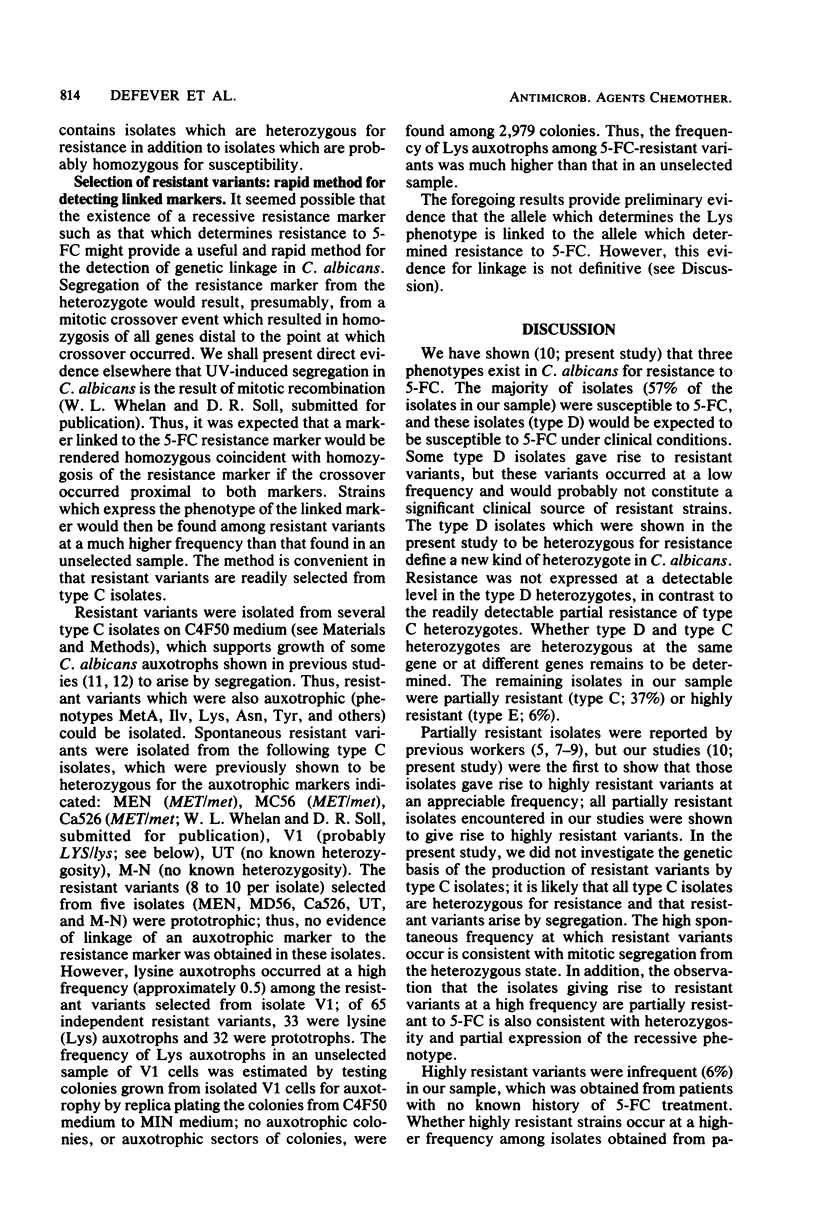Abstract
Resistance to 5-fluorocytosine was studied in 137 independent Candida albicans clinical isolates. Seventy-eight isolates (57%) were susceptible; 51 isolates (37%) were partially resistant; 8 isolates (6%) were highly resistant. All partially resistant isolates gave rise to variants which were highly resistant. Some susceptible isolates gave rise to variants which were highly resistant; two such isolates were shown to be heterozygous for resistance, and these isolates define a new type of heterozygote. A partially resistant isolate gave rise to resistant variants which were auxotrophic for lysine; this result was interpreted as preliminary evidence that the allele which determined resistance was linked to an allele which determined auxotrophy for lysine. It is suggested that heterozygotes constitute a source of preexisting mutant alleles which determine resistance, and that 5-fluorocytosine treatment of infections due to heterozygotes may result in significant selection for resistant variants. A simple screening procedure is described by which partially resistant strains may be recognized.
Full text
PDF





Images in this article
Selected References
These references are in PubMed. This may not be the complete list of references from this article.
- Bennett J. E. Chemotherapy of systemic mycoses (first of two parts). N Engl J Med. 1974 Jan 3;290(1):30–32. doi: 10.1056/NEJM197401032900107. [DOI] [PubMed] [Google Scholar]
- Bennett J. E. Chemotherapy of systemic mycoses (second of two parts). N Engl J Med. 1974 Feb 7;290(6):320–323. doi: 10.1056/NEJM197402072900607. [DOI] [PubMed] [Google Scholar]
- Hoeprich P. D. Chemotherapy of systemic fungal diseases. Annu Rev Pharmacol Toxicol. 1978;18:205–231. doi: 10.1146/annurev.pa.18.040178.001225. [DOI] [PubMed] [Google Scholar]
- Holt R. J. Clinical problems with 5-fluorocytosine. Mykosen. 1978 Nov;21(11):363–369. doi: 10.1111/j.1439-0507.1978.tb01598.x. [DOI] [PubMed] [Google Scholar]
- Normark S., Schönebeck J. In vitro studies of 5-fluorocytosine resistance in Candida albicans and Torulopsis glabrata. Antimicrob Agents Chemother. 1972 Sep;2(3):114–121. doi: 10.1128/aac.2.3.114. [DOI] [PMC free article] [PubMed] [Google Scholar]
- Olaiya A. F., Sogin S. J. Ploidy determination of Canadida albicans. J Bacteriol. 1979 Dec;140(3):1043–1049. doi: 10.1128/jb.140.3.1043-1049.1979. [DOI] [PMC free article] [PubMed] [Google Scholar]
- Polak A., Scholer H. J. Mode of action of 5-fluorocytosine and mechanisms of resistance. Chemotherapy. 1975;21(3-4):113–130. doi: 10.1159/000221854. [DOI] [PubMed] [Google Scholar]
- Schönebeck J., Anséhn S. 5-Fluorocytosine resistance in candida spp. and Torulopsis glabrata. Sabouraudia. 1973 Mar;11(1):10–20. doi: 10.1080/00362177385190041. [DOI] [PubMed] [Google Scholar]
- Shadomy S. Further in vitro studies with 5-fluorocytosine. Infect Immun. 1970 Oct;2(4):484–488. doi: 10.1128/iai.2.4.484-488.1970. [DOI] [PMC free article] [PubMed] [Google Scholar]
- Whelan W. L., Beneke E. S., Rogers A. L., Soll D. R. Segregation of 5-fluorocytosine-resistance variants by Candida albicans. Antimicrob Agents Chemother. 1981 Jun;19(6):1078–1081. doi: 10.1128/aac.19.6.1078. [DOI] [PMC free article] [PubMed] [Google Scholar]
- Whelan W. L., Magee P. T. Natural heterozygosity in Candida albicans. J Bacteriol. 1981 Feb;145(2):896–903. doi: 10.1128/jb.145.2.896-903.1981. [DOI] [PMC free article] [PubMed] [Google Scholar]
- Whelan W. L., Partridge R. M., Magee P. T. Heterozygosity and segregation in Candida albicans. Mol Gen Genet. 1980;180(1):107–113. doi: 10.1007/BF00267358. [DOI] [PubMed] [Google Scholar]



